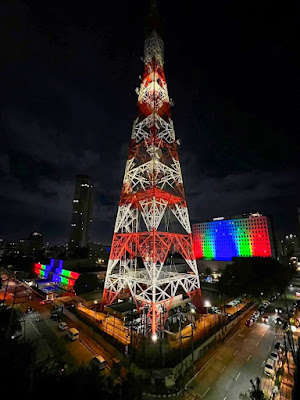Wazzup Pilipinas!?
When the seat of a nation meets the summit of the sky, what you get isn’t just altitude — you get attitude. These capital cities aren't just centers of governance; they're testaments to human resilience, creativity, and cultural richness forged at the edges of the Earth’s habitable limits. From colonial-era citadels perched in the clouds to spiritual sanctuaries hidden in Himalayan valleys, here are the ten highest capital cities in the world — where power is literally on top of the world.
10. Nairobi, Kenya – 5,889 feet (1,795 meters)
The Urban Jungle Where Modernity Roars and Nature Stalks
Nairobi’s skyline may glitter with the ambition of a modern African hub, but just beyond its steel-and-glass horizon lies the wild heart of Kenya. Established in 1899 as a swamp-side stop on a British colonial railway, Nairobi — "the place of cool waters" in Maasai — has transformed into East Africa’s economic nerve center. Wildlife and urban life intermingle here: it’s the only capital city on Earth with a full-fledged game park (Nairobi National Park) within its limits. Safari seekers roam among giraffes and lions by day, while dealmakers and dreamers hustle through streets lined with markets, museums, and memories of resistance and revolution by night.
9. Tehran, Iran – 6,003 feet (1,830 meters)
Where Empires Sleep and Revolutions Whisper
Tehran is a city of layers — ancient bazaars buried beneath boulevards, palaces swallowed by modern towers, desert dust clashing with alpine frost. Sitting in the shadow of the Alborz Mountains, it is a place of tension and contrast — between old-world opulence and new-world ambition, East and West, religion and rebellion. From the grandeur of Golestan Palace to the audacity of the Milad Tower, Tehran is a capital that doesn’t ask for your attention — it demands it. And in its altitude, you feel not just thinner air, but the weight of a civilization that has endured dynasties, upheavals, and the judgment of history.
8. Mexico City, Mexico – 7,350 feet (2,240 meters)
An Aztec Heartbeat in a Megacity’s Chest
Built upon the ruins of a floating empire, Mexico City pulses with ancient echoes and modern rhythm. Its cobbled historic center — the Zócalo — rests atop what was once Tenochtitlan, the dazzling island capital of the Aztecs. Conquered, reconstructed, and colonized, this high-altitude megalopolis now stands as a cultural titan of Latin America. Art splashes across building facades, from Diego Rivera murals to the haunting colors of Frida Kahlo’s Casa Azul. At over 7,000 feet, the elevation grants not just literal perspective, but a sweeping view of the city’s enduring spirit through centuries of conquest, revolution, and reinvention.
7. Sana’a, Yemen – 7,382 feet (2,250 meters)
A City of Myths, Minarets, and Miracles
Step into Sana’a and you step into a storybook — one written in mudbrick and minaret, calligraphy and chaos. One of the oldest continuously inhabited cities in the world, Yemen’s capital is steeped in tales so ancient they predate recorded history. The Old City’s distinctive brown-and-white gingerbread-style houses, adorned with decorative friezes and geometric windows, rise like relics from a forgotten dream. Here, time slows, chants from mosques echo like lullabies, and every alleyway tells a legend. Though conflict has tested Sana’a’s resilience, its sky-high perch reminds us that even amid adversity, cultural majesty can still endure — and even flourish.
6. Asmara, Eritrea – 7,628 feet (2,325 meters)
The African City That Looks Like an Italian Time Capsule
Asmara is unlike any other capital in Africa — or the world. Dubbed “Little Rome” during its time as the capital of Italian Eritrea, the city feels frozen in a surreal past where Art Deco meets East African highlands. From the swooping curves of the Fiat Tagliero building to the serene stillness of palm-lined boulevards, Asmara is both a relic and a rebellion — against the homogeneity of global capitals. At its heart lies a story of unity and resistance, as four ancient clans came together to forge the community that would one day become this UNESCO-protected, pastel-hued gem in the clouds.
5. Addis Ababa, Ethiopia – 7,726 feet (2,355 meters)
Where African History Walks With You
Addis Ababa, or “New Flower,” is a poetic paradox — chaotic yet graceful, old yet awakening. Perched at the highest point of any African capital, Addis is the political soul of the continent, home to the African Union and the seat of pan-African diplomacy. Founded by royalty, built during imperial dreams, and reshaped through occupation and resistance, this city doesn’t just hold Ethiopia’s history — it is Ethiopia’s history. Museums housing Lucy, one of humanity’s oldest ancestors, rub shoulders with lively markets selling injera and spices. Here, past and present cohabitate at altitude — a city always in bloom.
4. Bogotá, Colombia – 8,660 feet (2,640 meters)
Where Culture Climbs as High as the Mountains
Bogotá is Colombia’s cerebral cortex — elevated in both altitude and intellect. Anchored in the Andes and thriving in rhythm, the city is a cultural laboratory where every street corner bursts with art, music, and radical thought. Its beating heart is La Candelaria, a kaleidoscope of colonial-era streets, colorful graffiti, and historic rebellion. Yet this highland capital doesn’t stop at beauty; it’s also home to the country’s top universities and think tanks. Bogotá invites visitors to rise — physically and mentally — into a world where ideas, identity, and innovation swirl in the mountain mist.
3. Thimphu, Bhutan – 8,688 feet (2,648 meters)
The Peaceful Pinnacle of Himalayan Harmony
Thimphu, Bhutan’s serene capital, is unlike any city you've ever known — or will ever forget. It’s a place where the Gross National Happiness Index trumps GDP, where Buddhist monks walk the same streets as digital nomads, and where not a single traffic light flashes. Nestled in a valley where clouds cradle mountaintops and prayer flags flutter like whispers to the divine, Thimphu is a spiritual sanctuary disguised as a city. Here, palatial dzongs overlook rivers and rituals, and nature is not an escape — it’s the essence. At 8,688 feet, every breath feels like a meditation.
2. Quito, Ecuador – 9,350 feet (2,850 meters)
A City on the Equator That Reaches for the Stars
In Quito, altitude meets attitude. This breathtaking capital sits just miles from the equator but stretches skyward into the Andes with the soul of a civilization layered in centuries. Its baroque churches, Spanish colonial facades, and ancient plazas whisper of conquistadors and pre-Incan legacies. But Quito is not just a monument to the past — it is a vibrant center of Ecuadorian identity, a city humming with salsa music, artisan markets, and culinary surprises. The views are dizzying, the architecture dazzling, and the air thin enough to make every experience feel sublime — or surreal.
1. La Paz, Bolivia – 11,942 feet (3,640 meters)
The Capital That Defies Gravity and Convention
Welcome to La Paz — the world’s highest seat of government and perhaps its most otherworldly. Here, oxygen is scarce but color is abundant, spilling from market stalls, murals, and mountain slopes. Cradled in a vast canyon and watched over by snow-capped Mount Illimani, La Paz is a city that doesn’t just touch the clouds — it commands them. Whether you’re gliding on the world’s largest urban cable car system or wandering through the Witches’ Market, La Paz always feels like a dream teetering on the edge of reality. It’s a city of paradoxes, of power and poverty, of colonial architecture and indigenous pride, of rituals and revolutions — and it all happens nearly 12,000 feet above sea level.
A Final Word from the Heights
These ten capitals are not simply political centers — they are living, breathing summits of human ingenuity and spirit. At these elevations, the horizon expands, and so does one’s sense of what’s possible. Whether nestled in misty valleys or perched atop plateaus, these cities remind us that greatness doesn’t always come from being at the center — sometimes, it’s born from being above it all.




























%202024.jpg)



.jpg)
























 Ross is known as the Pambansang Blogger ng Pilipinas - An Information and Communication Technology (ICT) Professional by profession and a Social Media Evangelist by heart.
Ross is known as the Pambansang Blogger ng Pilipinas - An Information and Communication Technology (ICT) Professional by profession and a Social Media Evangelist by heart.






.jpg)




